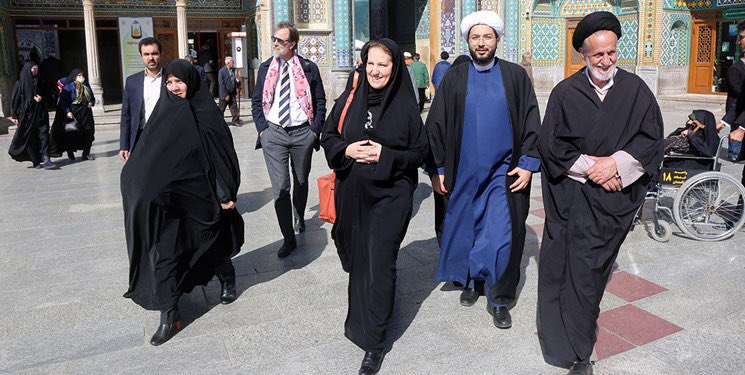
Swiss ambassador in Iran criticised for chador appearance

The Swiss ambassador to Iran wore a chador while visiting a Shiite holy city in the Islamic Republic. The foreign ministry has rejected criticism.
Online criticism was directed at Nadine Olivieri Lozano after pictures emerged this week of her visit to the pilgrimage city of Qom dressed in a “chador”, a full-body-length piece of Islamic clothing.
On Twitter, British-Iranian actress Nasanin Boniadi wrote that wearing conservative religious clothing, at the same time that other Iranian women are risking everything for more freedom, is “exactly what you should not do”.
Various other users joined in, including Belgian parliamentarian Darya Safai: “while millions of Iranian women are fighting for women’s rights […] she wears a hijab and makes publicity for the oppressors”, Safai wrote on Twitter.
In Switzerland too, some complained that the ambassador’s clothing choice looked like a sign of support for the Iranian regime. Centre party parliamentarian Marianne Binder-Keller said it was a slap in the face for those currently protesting.
“To me it looks clumsy, to allow yourself to be pictured like that,” she told Swiss public television SRF. “These pictures can be instrumentalised, and that’s indeed what happened.”
+ Iranian protests test Switzerland’s special status with Iran
Anti-regime protests
Since September last year, Iran has been the site of repeated protests against the ruling religious and political regime, sparked by the death in police custody of Mahsa Amini.
A few days before her death, the young Kurdish woman had been arrested for flouting the rules governing Islamic attire in the country. Her family says she was the victim of police aggression before her death.
Human rights watchers say that more than 500 people have been killed since the protests began; various demonstrators have been executed.
Protests have also taken place in Switzerland in solidarity with the Iranian movement, while the government’s Iran policy has come in for criticism.
Saïda Keller-Messahli, president of the Swiss-based Forum for a Progressive Islam, told SRF that the ambassador’s appearance was “without courage”.
Switzerland could make use of its special status in relation to Iran, where it represents the diplomatic interests of the US, said Keller-Messahli. That is, Lozano could have refused to wear the chador: “you don’t have to accept everything the regime wants to impose on you,” she said.

Foreign ministry reacts
The Swiss foreign ministry wrote following the criticisms that the ambassador had visited an academic institution in Qom which allows students to participate in interfaith seminars in Switzerland. During the visit to the shrine, she observed the existing dress protocol for women, the ministry said.
It stressed that Switzerland has repeatedly and clearly taken a stand on human rights violations in Iran, and has repeatedly condemned the use of violence against demonstrators.
+ Switzerland condemns violence by Iranian security forces
At the same time, the foreign ministry said, interfaith dialogue is of great importance in the current context. Switzerland uses all channels within the framework of its good offices to promote exchanges, it said.
Regime recognition
For the University of Bern Islam scholar Reinhard Schulze, however, the appearance is indeed problematic. “The main problem was that it took place in the context of the revolt in Iran. This gave recognition to the regime,” he told SRF.
For Iran, foreign recognition is important because it has lost it at home, he said. That is why Iran deliberately wanted to disseminate the images, Schulze said.
There has also been criticism in the Swiss press. This was “not a case of putting one’s foot in one’s mouth or of neutral foreign policy,” wrote newspapers from the Tamedia group. “Switzerland is clearly taking sides with the mullah regime.”
The Neue Zürcher Zeitung quoted Kijan Espahangizi, a historian and private lecturer at the University of Zurich with Iranian roots. He says the pictures from Qom are “even more of a disaster” for Switzerland’s image than the recent congratulatory note sent to Tehran by Swiss President Alain Berset on the occasion of the 44th anniversary of the Islamic Revolution.
However, Blick quotes Tim Guldimann, an ex-parliamentarian and former Swiss ambassador in Teheran, who was less keen to criticise: “It’s completely out of line that a diplomat’s clothing should be interpreted as a show of sympathy towards the Iranian regime”, Guldimann says. Lozano was simply acting in accordance with the law: “When we send diplomats, they have to respect the rules. The alternative would be to break off diplomatic relations. I don’t think anyone wants that,” Guldimann said.

In compliance with the JTI standards
More: SWI swissinfo.ch certified by the Journalism Trust Initiative


























You can find an overview of ongoing debates with our journalists here . Please join us!
If you want to start a conversation about a topic raised in this article or want to report factual errors, email us at english@swissinfo.ch.